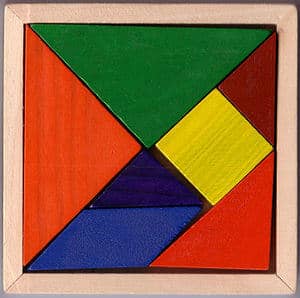In this blog post, our regular guest blogger Joanne Arcand, tackles tangrams – literally. She gives us lots of great resources for putting together tangram puzzles.
By Joanne Arcand

There is an ancient Chinese legend (for a picture book version of the story, check out The Warlord's Puzzle by Virginia Walton Pilegard), which tells of a tile maker presenting the warlord with a large square tablet, so beautiful that its green colour had never been seen before. In his excitement, the maker dropped it and it broke into seven pieces: a square, a parallelogram, and five triangles.
The warlord became enraged, but then offered a handsome prize to anyone that could put the pieces back together. The townspeople lined up for miles, and no one was successful. In a Disney-esque ending, a fisherman who had to stop working because the lineup of people was making the waters muddy finally solved the puzzle and became rich (Someone bring the queen a broken tile, I could use some Christmas funds!).
Using puzzles to support the math curriculum
Tangrams are an excellent puzzle for both young and old alike. To start, print off the tangram shapes onto tag board or cut them out of a magnetic sheet. The pieces can be rearranged back into a square, or a parallelogram, or a triangle, or any number of animals. Discuss how the two small triangles can be made into the medium triangle, the parallelogram, or the square. All seven shapes can be used to make any of the shapes which make up the tangram. This concept of splitting large areas up into smaller parts is a vital part of the understanding of area, and helps with problems such as calculating the area of the irregular living room floor.
Take ¼ of ¼ of ½…and other fractional issues

Tangrams can also be used to help understand fractions. A guide to the fractional equivalents of the tangram pieces can be found here. Print out a few tangram sets and use them to compare fractions (greater than or less than), to add or subtract fractions and also to reduce fractions to lowest terms. A bonus of the tangrams is that the set covers the more common fractions, with the exception of 1/3. You could print out a square the same size of the tangram and split it into three so that you have that fraction covered as well.
Tangrams teach logic and problem solving
We’ve all forgotten the presence of a small child and let out a stream of expletives at a particularly challenging task. Once you’ve thoroughly cleansed that tongue with the Ivory, it might be time for a break. Your son/daughter needs to see you demonstrate how best to deal with problems, or “you just don’t understand” will be his/her chant in later years when you tell him or her to “keep trying”.
Try a few tangram puzzles. I like to enlarge them and print them out so I can try one at a time. When you run into difficulty (they don’t call it the “Seven Boards of Cunning” for nothing), talk about the strategies you are using, and why you think the strategy might work.
With that swear word at the tip of your tongue, bite it and remember. The most important step in problem solving is evaluating the success of the attempt and looking for options when you run into difficulty. By talking through the strategies, you are teaching your child logical reasoning, problem solving methods, and persistence.
The preceding lessons are, I find, best done with brownies baking in the oven. That way, there’s either consolatory or celebratory chocolate after 20-25 minutes!
Joanne Arcand is trying to juggle her role as a math teacher with her other life as mom of twin boys. She lives in Oakville, Ontario.

